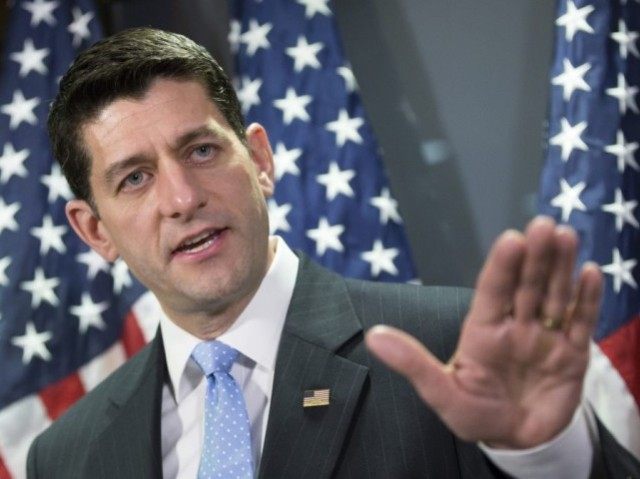This week, Speaker Paul Ryan and House leadership introduced an Obamacare replacement bill. They said it was the culmination of months of discussion and input with members of the GOP caucus in the House. “We listened to our members,” they said, and this was the result.
It turns out that isn’t the case at all. The House Freedom Caucus and conservative groups like Heritage Foundation, Americans for Prosperity, Freedomworks and Club For Growth—among others—came out opposing the plan. And the furor began. What’s being revealed as this plays out is the real challenge it will be to “drain the swamp.” And as the fault lines between conservatives and leadership in the House widen, the Trump agenda is truly at risk.
Paul Ryan in his now famous “PowerPoint Press Conference” sent a message to the House Freedom Caucus and conservative groups. “They don’t understand the reconciliation process,” he said. He drew a line in the sand against to their efforts when he said, “The time is here. The time is now. This is the moment, and this is the closest this will ever happen. It really comes down to a binary choice.”
It’s a binary choice over something which has no costs associated with it. The Congressional Budget Office has not released their report on its budget effect. And some members of Congress are openly concerned the report might show severe impacts on future spending. House leadership hasn’t been forthcoming on the fiscal impact either.
Paul Ryan has been sending a message to conservatives. He is telling them to either accept the plan or not. And while conservatives aren’t yet falling into line, an effort to oppose them during the 2018 campaign is beginning to emerge. It may be a repeat leadership’s 2016 efforts to take out conservative members.
Just this week, a group began a $500,000 ad campaign targeting 30 House Freedom Caucus members calling upon them to support what is now being called Ryancare. Similar efforts were initiated against Freedom Caucus members like Paul Gosar (R-AZ) and Tim Huelskamp (R-KS) last year taking out Huelskamp.
Ultimately, Paul Ryan is causing severe harm to the agenda of President Trump. The Speaker knew the bill he released would have strong opposition from conservatives. Sen. Rand Paul was already explaining the reasons for opposition when he complained how the House was hiding the bill in the last few weeks. As the politics in the House continues to deteriorate, there is speculation that while feigning support for the President’s agenda, House leadership is using the legislation to set up an electoral fight with conservatives next year.
I found myself in the middle of this give and take serving Cong. Tim Huelskamp as his Chief of Staff. Immediately after the 112th Congress began in January 2011, leaders in the House offered a spending cut of $38.5 billion in the budget. They claimed they were taking aggressive steps to get spending under control. But no CBO report had been issued to confirm that number. Our office found the actual CBO research which revealed the cut was only $352 million (not ‘billion’ but ‘million’). House leadership was apparently hiding the report. We released it to a furor of condemnation in the House. I met with Boehner’s Chief of Staff Barry Jackson. He was furious. I’ll just say this meeting set the tone for the ongoing backlash against House Freedom Caucus members and John Boehner ever since.
A typical pattern emerged in the House after 2011. Bills were written in the Speaker’s office. They were forced through the committees with limited amendments. They proceeded to the Rules committee which is stacked with members loyal to the speaker. Conservative amendments were killed there. And the bill reached the floor with rules taking away the right of members to amend the bill.
Conservatives have been shut out of the process for years. And it seems nothing has changed.
The House could have offered a full repeal bill. Speaker Ryan is making a passionate plea against the idea saying it would be filibustered in the Senate and die. But experts are saying that might not be the case at all.
Reconciliation is a mystery to the average American—mostly because members of Congress make it so. Reconciliation is a process created through the Congressional Budget Act of 1974 that allows changes to budget items to “reconcile” with the then current budget on a simple majority vote. Spending items only are allowed under Reconciliation.
Some experts believe Congress can pass a full repeal of Obamacare in a reconciliation bill. Paul Winfree of the Heritage Foundation argued this in a Politico article last November:
“…it is clear that those rules are inseparable from the rest of the ACA’s structure. In fact, the Obama administration argued this before the Supreme Court in King v. Burwell, the case over whether enrollees who buy insurance through the federal exchange are eligible for subsidies. As a result, Congress may repeal those regulations via reconciliation.”
The Senate Parliamentarian could certainly rule against a bill with full repeal language, but there is a simple fix to that. The presiding officer can rule against the parliamentarian, and the Senate can overrule her with a simple majority vote.
GOP leadership in the Senate and House know this. But they are unwilling to take the risk.
This is where President Trump can use his political heft to bring a solution. And it just might save his agenda from an initial defeat.
He can sit down with Speaker Ryan, Mitch McConnell, and conservatives and hash out a full repeal now. President Trump can send Mike Pence to the Senate to override any negative ruling by the parliamentarian, and Obamacare can go to the ash heap of history.
The Swamp doesn’t want this. But Donald Trump could once again defy the odds and make winning great again.

COMMENTS
Please let us know if you're having issues with commenting.